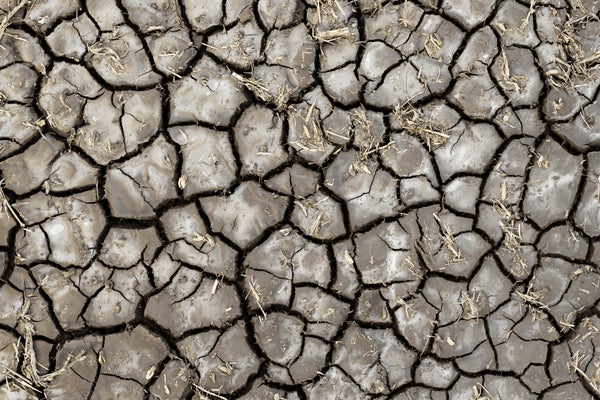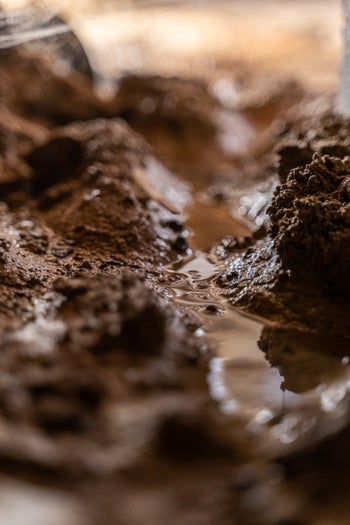California Drought And Your Home’s Foundation
Table of Contents
1. What Exactly Is A Drought?
2. Expansive Clay Soil Causes The Most Foundation Damage During A Drought
3. How Does Drought Affect The Soil Underneath Your Home’S Foundation?
4. Signs Of Foundation Damage Caused By Drought
5. How To Repair Foundation Damage Caused By Drought

The damage caused by most natural disasters like earthquakes, floods, and sinkholes is easy to see—damage caused by drought not so much. However, just because you can’t easily see the damage doesn’t mean it’s not happening. Drought can cause severe structural damage to a foundation.
In this article, we’re going to define a drought, discuss how certain soil types make a foundation more susceptible to damage, repair options, and more.
What Exactly Is A Drought?
According to National Geographic, a drought is a…
‘’…period of time when an area or region experiences below-normal precipitation. The lack of adequate precipitation, either rain or snow, can cause reduced soil moisture or groundwater, diminished stream flow, crop damage, and a general water shortage.’’
On top of all that, droughts can also cause significant foundation damage.
Droughts can last anywhere from a few weeks to a decade or more, and it isn’t always easy to say when a drought starts and stops. But, even a drought lasting only a few weeks might be enough to cause foundation damage.
Here’s how we explain the effects of drought to California homeowners:
Everyone’s home moves up and down as the seasons cycle between wet and dry. One door works better during the summer while another door works better during the winter. This is perfectly normal. However, some homes have areas that sink slightly more during the dry season than they raise back up again during the wet season. (There are various reasons for this including the house’s weight and the properties of the soil under it.) This settlement may not be noticeable over just one or two years because it’s so slight, perhaps only 1/8” or 1/16” lost each year. However, these small amounts add up. That tiny 1/8” each year becomes 1-1/4” over 10 years and 2-1/4” over 20 years. This kind of settlement will definitely be noticeable. Add to this the fact that during a drought the dry season is longer than the wet season, so the house will sink even more during a drought year. Right now people who have been in their homes for 10-20 years are calling us and saying, ‘’We knew we had a small amount of settlement, but it got worse this past year.’’
As of February 2019, the town of Arbuckle has sunk over 2 feet due to drought. What’s going on under your home is similar but on a much smaller scale.
Expansive Clay Soil Causes The Most Foundation Damage During A Drought
To understand drought, you first need to understand soil because certain types of soil put your California home’s foundation at greater risk of suffering drought-caused damage.
There are four main soil types: sandy, silty, clay, and loam. Each of these soil types reacts differently to weather changes involving water. Foundations built on expansive clay soil fare the worst during droughts because clay soil expands when it soaks up moisture and then shrinks by that same amount when it dries out. In the next section, we’ll discuss how this feature of clay soil can cause structural damage to a foundation during a drought.
Many homes in California sit atop expansive clay soil.
How Does Drought Affect The Soil Underneath Your Home’S Foundation?
As we pointed out above, expansive clay soil swells when it absorbs moisture and shrinks when it dries out. Parched clay soil – the kind that happens during droughts – shrinks and can create voids under a foundation. When the house starts to sink into these voids, it will develop foundation problems.

Signs Of Foundation Damage Caused By Drought
Signs of foundation damage include,
- Windows and/or doors that are difficult to open and close – If this is just one door, it might not be a sign of foundation damage. However, if multiple windows and/or doors have the same problem, you should contact a foundation repair contractor and ask for an inspection.
- Uneven floors
- Ceilings and/or floors that are no longer in contact with the walls
- Cracked floors – Look for cracks that stretch wall-to-wall. Cracks limited to one or two tiles probably happened when something was dropped on the floor.
- Wall cracks
- Torn wallpaper – This might be a sign of a cracked wall behind the wallpaper.
- Bowed walls
- Diagonal cracks stretching from the corners of windows and/or doors up toward the ceiling
- Moldings that have separated from the wall and/or ceiling
- Stair step cracks in brickwork
- Chimney and porches that are starting to lean away from the house
You could also walk around your home, looking for any gaps between the soil and the foundation.
Read more – Pier And Beam Foundation Repair
How To Repair Foundation Damage Caused By Drought
Fortunately, almost all foundation problems caused by drought are repairable. Only very rarely would a foundation need to be replaced.
The following permanent repair solutions will stabilize and lift the foundation. Even if there’s another drought, these solutions will protect your foundation from damage.
Resistance push piers Heavy-duty steel push piers are driven deep down into the ground until they reach load-bearing soil. Synchronized hydraulic jacks then lift the building back up.
Read more about – Drilled Concrete Piers
Screw Jacks
Most of our recent crawl space foundation inspections here in California have uncovered problems involving expansive soil. We can see that the posts in these crawl spaces are really starting to feel the effect of the drought. Fortunately, the problem can be fixed by simply removing and replacing the posts with screw jacks. This will stabilize the foundation and lift the floor back into position.
It’s important to note, though, that screw jacks are not drought resistant. They will need to be adjusted more frequently during drought years. However, the positive thing about screw jacks is that they are adjustable. Once they’ve been installed, you don’t need to keep replacing or shimming posts. All you need to do is crank a wrench, and you’re done.
Helical piers
Helical piers are usually used for new construction projects. However, sometimes they’re used to repair lightweight, existing foundations. They look like giant screws and are turned into the soil until they reach the load-bearing strata. Once they’re in place, synchronized hydraulic jacks lift the building back up.
Drilled concrete piers
Drilled concrete piers are drilled down into the bedrock beneath the foundation. They are especially useful in stopping lateral movement related to soil creep.
Slab piers
Slab piers Slab piers are push piers or helical piers installed through small holes in the slab. Anchors are inserted through the holes until they hit the load-bearing strata. Steel brackets then fasten the anchors to the foundation.
Drought is a natural disaster that can cause structural damage to your home’s foundation. However, the good news is that drought-caused damage can be repaired using one of the above techniques.
If you think your home’s foundation has a problem caused by drought and you’re in our service area in Northern California, contact us today for a free inspection and repair estimate.
More Resources
Publish Date:
Last Modified Date:

Our Locations
2333 Courage Dr. Suite C
Fairfield, CA 94533
1161 N Fair Oaks Ave
Sunnyvale, CA 94089



